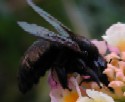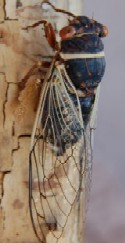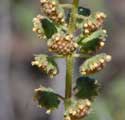March
Mar 25 (2006): The first of the male carpenter bees emerged from their overwintering cells in the old agave stems. Read below why they emerge ahead of the females.
Mar 22 (2003): Rainfall this spring has yielded a bumper crop of plant feeding insects of all kinds. Caterpillars from nuctuid moths are particularly abundant and are munching nearly every plant in the garden. Aphids, too, are numerous. Predators such as minute wasp parasites and syrphid flies are gaining ground quickly, meaning that the plant feeder numbers will soon be checked.
Mar 20 (1998): The flower buds on the Canyon Ragweed are nearly ready to open up. The green flowers are not attractive, and furthermore they send airborne pollen grains into the breeze that make me and lots of other folks sneeze. For that reason, I may prune most of the flower buds. I have discovered on the ragweed several Mealy Bugs (Pseudococcidae). I speculate that they came from eggs laid on the plant last fall, having hatched a month or so ago. The nymphs (as young mealies are called) are now about half-grown, oval and somewhat flattened, and measure about 3 mm in length. Their color is bright white due to a powdery coating of wax.
Mealy bugs are ‘True Bugs’ belonging to the insect order, Homoptera. The most important characteristic is the piercing-sucking mouthparts that the insects use to draw liquid plant sap for nourishment. The legs are very short and the bugs, like their relatives the aphids, rarely move about. They are content to stay in one spot, continuously drawing sustenance from the plant. But, the mealy bugs also inject an irritating chemical into the plant tissue that causes the leaf upon which they're feeding to curl up, thus providing a bit of shelter for the bugs. If I want to see the bug, I can carefully unfurl the leaf. Within the curled leaf I also find shiny, sticky honeydew.



